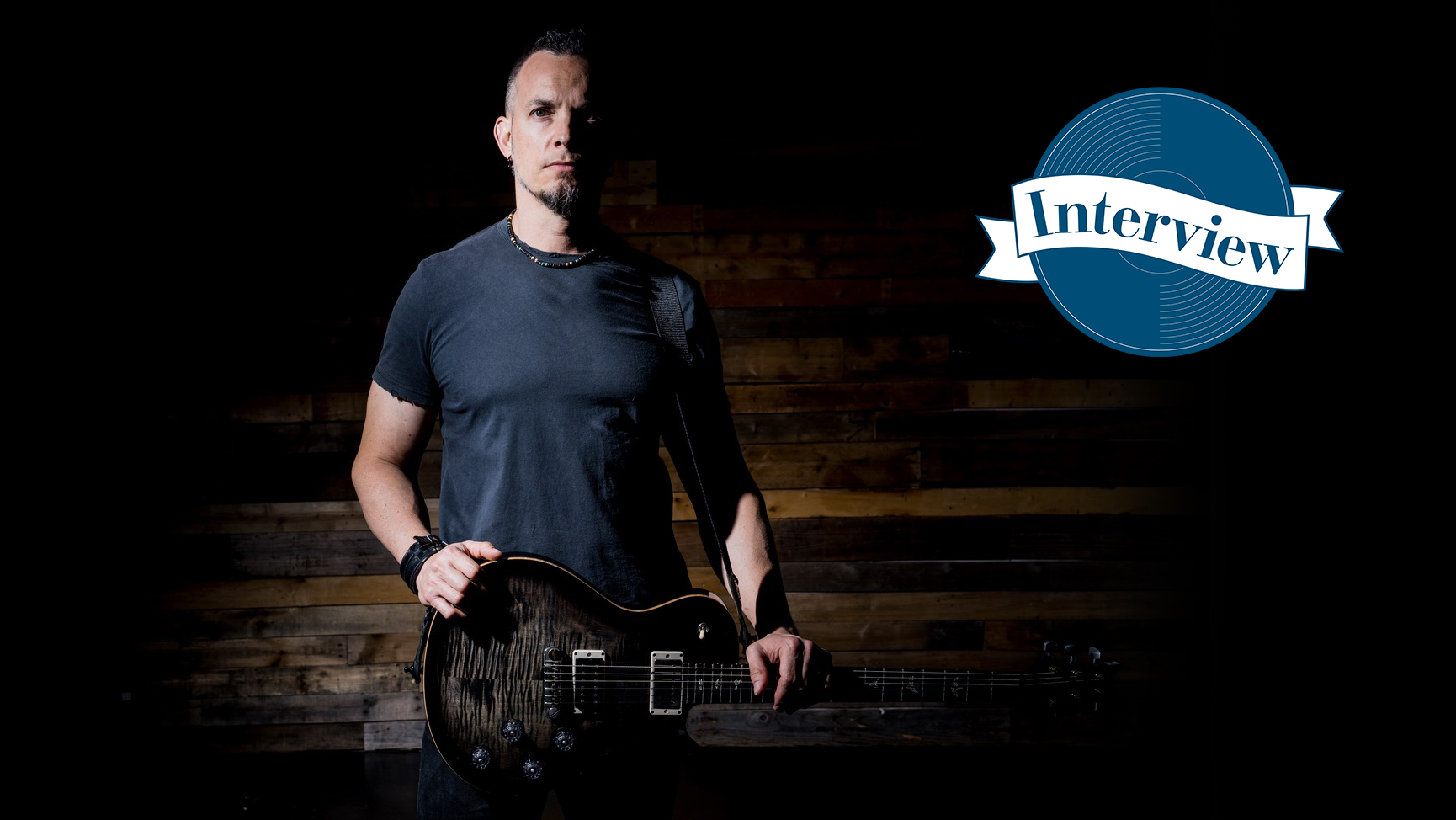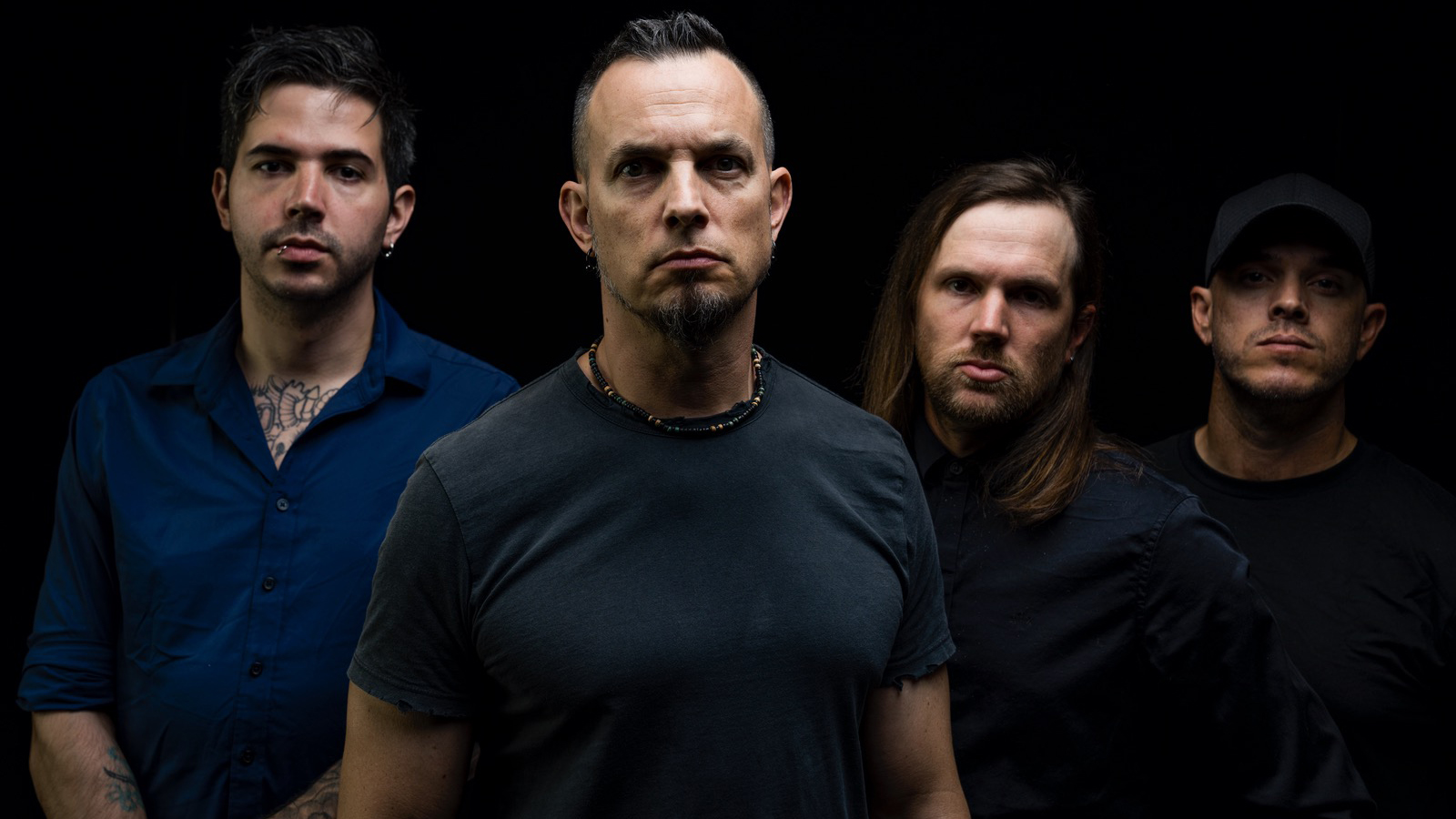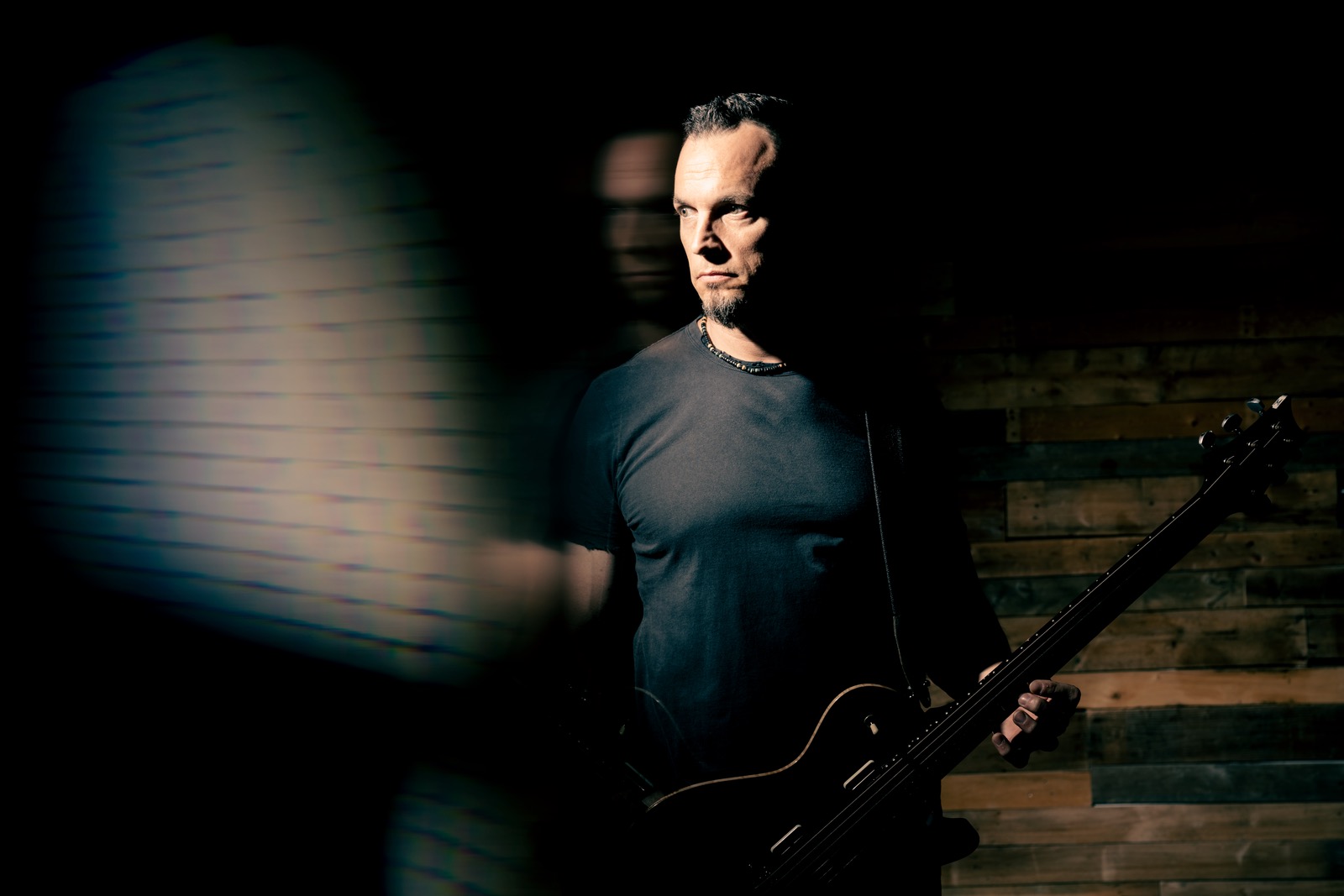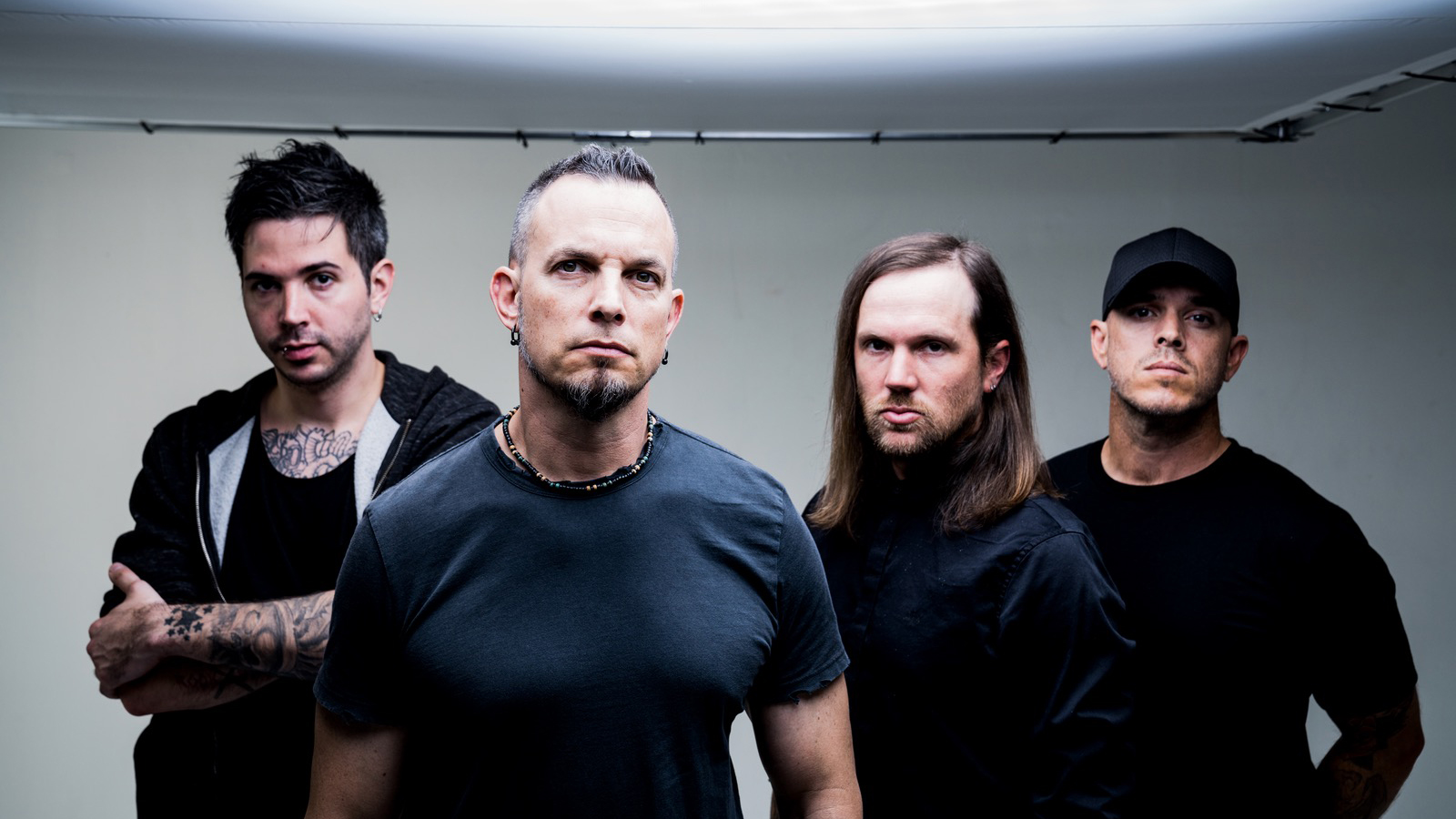
Guitar Showcase 2021: As the driving force behind three successful bands over the last 25 years, it took an international lockdown to derail Mark Tremonti from his relentless and prolific recording and touring cycle. And for a while at least, he dealt with it in much the same way as many of us.
“Well, just like the rest of the world, I got in quite a deep, dark hole for about four or five months," he reflects. "I wasn’t too interested in playing a ton of guitar or writing music, so I just found other ways to consume my time. I moved back into my old house so I had pretty much go through my house and be a handyman. I painted my house, I fixed this, I fixed that. Then once I kind of snapped out of it it was great to get back to writing this record."
There was also the new addition of a daughter, Stella, to his family in that time, but Mark is now back out touring the US with his band Tremonti and a new album Marching In Time out today (24 September) to celebrate too.
While the impassioned title track is inspired by the arrival of his daughter, the record as a whole became a vital focus for a musician who is simply not used to pausing his musical career.
“I think writing this record was kind of therapy too. It was exciting to get back to creating again and from there I was just creating like crazy. So I recorded this record, and I’m recording another record that’s going to come out next year and I’m supposed to go into the studio next April with the Alter Bridge guys. So it’s time to get back at it.”
Another Tremonti record?
“The other one is a secret record. A top secret record that’s going to be announced in the Spring of next year and it’s going to be all for charity and I’m really excited about it.”
Want all the hottest music and gear news, reviews, deals, features and more, direct to your inbox? Sign up here.
You're obviously playing guitar on that?
“I don’t know [laughs] I don’t know what I’m going to do - it’s top secret!”
Not flute?
“It’s not the flute.”
Back to this album then, you have a system of songwriting that obviously works judging by how prolific you’ve been over the years. Did being at home for so long this time change your creative process at all?
“I just have to work it out with the wife and kids and say, ‘Once this time hits it’s time for me to go to work.’ Because when I’m on the road I can take all day long and write but when I’m at home there’s soccer practice, there’s this and there’s that.
“I would maybe work from 8 o’clock at night to whenever felt it was time to go to bed - 2 o’clock in the morning sometimes. But then Eric Friedman flew into town and usually when I get together with Myles or Eric to get rough comps of songs for preproduction, that will only take a couple of weeks. But with this, we had three months too do that. There were no deadlines, it was just a good time to go through and leave no stone unturned. Look at every single option and rewrite songs and really polish them.
“Sometimes I think a record is great when you capture lightning in a bottle, sometimes they’re great when you can work the hell out of them to get them perfect. If you look at Alter Bridge, Blackbird was a very polished [process], we spent tons of time on that record, whereas another record like The Last Hero was done lighting in a bottle; quickly. You get a different energy out of both records, which is good. I think it’s good to mix that up. This record was definitely more well thought out, pre-planned, and when we went into the studio we were 100 per cent done with lyrics, songs, arrangements, everything.”

When the time comes for finishing a song, I will usually either tap tempo a metronome or Google a 120 BPM drum loop
Charting your musical evolution through Tremonti, it seems like rhythmically you’ve become more ambitious and you really mix things up. A song like Thrown Further is a good example of that. It’s easy to get into comfort zones as a player so how do you go about challenging yourself?
“I think that’s another colour I love when it comes to songwriting – throwing different rhythm patterns in there. One thing, like on Marching In Time in particular, I wrote the verse of that song when I was doing a guitar clinic. I was telling people how I write songs and I stumbled upon that song. When the time comes for finishing a song, I will usually either tap tempo a metronome or Google a 120 BPM drum loop.
"This time I typed in a drum loop that was all over the place, which was more of a jazzy kind of thing that went in and out of time signatures. But it was at the same beats per minutes, so when I was recording it was a little distracting. I thought, I’ll just get the idea down.
“But the next day I listened to it and I thought, this could be great if I could take an idea like this and rewrite it to fit the song. That’s how the end of Marching In Time turned out to be in and out of feels. But I love that, it adds a dynamic to a song that makes it more interesting.”
The last song I wrote that I really dug, I was watching a Disney movie with my kids and this chord progression began and then I heard it going somewhere, and it didn’t go there
On Walk The Sky you brought in synth loops to inspire your songwriting, are you always actively looking for new ways spark ideas?
“Absolutely. Everyday I try to write something, I try to find some other way of being inspired. I’ve sat down with a guitar so many hundreds or thousands of times and thrown my fingers at the guitar and strummed away, writing something. I still do that a lot - I still do that more than half the time, but if you just do that all time, you feel like you’ve do it all before.
"I just bought a programme called Omnisphere which is really great. You hit one note of there and it does a whole world of cinematic stuff. I go and spend 500 bucks on a programme and you get something that could be five songs out of it and it’s worth every penny.
“I’ll also go on YouTube and look up ‘freestyle rap loop’ or something. Out of the rock n’ roll field that will make me play differently. Anything that will inspire me to do something.
“The last song I wrote that I really dug, I was watching a Disney movie with my kids and this chord progression began and then I heard it going somewhere, and it didn’t go there. So I thought, alright I’m going to make it go there and rewrite the mood I saw coming that didn’t happen. You never know where something is going to come from. I’ll be sitting at a restaurant and a song will come on, this happens to me a lot, and I’ll try to anticipate where the song is going. Then the song will go in a completely different direction and I’ll go where I anticipated it would go.
“Maybe I’ll use two notes from that and create a song from it. You never know where it’s going to come from.”
Anytime you can prevent people daydreaming through your song; catch their attention and keep throwing those mood changes in there, it’s a good tool
It’s easy to overlook the power of major and minor moods too. Let That Be Us begins and suggests a darker, heavy song but the chorus is upbeat and uplifting.
“The chorus is kind of a release from the dark tension of the verses. I remember doing a project back in the day where my record label at the time asked me if I wanted to do a song for one of the American Idol people. I said, ‘Absolutely, what do you have in mind?’ They said that they wanted me to look at the hot bands at the time. They wanted to do an alternative rock thing like 30 Seconds To Mars and My Chemical Romance. They said, ‘We want a song like that.’
“So I said I’d look at these bands and I averaged out their tempos and their vibes and I realised both those bands like to do that thing where they have either a minor, melancholy-type verse and then an uplifting positive chorus or the opposite.
"You have these dynamics and I think they work well. Whenever you change moods and tempos or how hard or soft you’re playing, it’s good. Anytime you can prevent people daydreaming through your song; catch their attention and keep throwing those mood changes in there, it’s a good tool.”

Sometimes it happens where I’ll go weeks or months without writing and then that one day will come along where it starts pouring out
How do you get over periods when you’re not feeling inspired to create?
“Right now I’m kind of going through that. I just completed this record and every time I complete a record I get the joy of being able to dive back into the guitar and not worry about writing another record, to just dive into learning all kinds of crazy new tricks on the guitar without having deadlines.
"With this [next] record I just got a call from my manager saying, ‘Alright we’ve got an April studio date’ so now I have to kind of dive back in, fast and furious to get that done by April. Sometimes when you have those looming deadlines, when you sit down to write and nothing comes out, it stresses you out. And it gets worse the next day and the next day. So I’m still chasing down that big day when it all starts pouring out.
“Sometimes it happens where I’ll go weeks or months without writing and then that one day will come along where it starts pouring out. I’m waiting for that day and it will come, I’ve been through it so many times and you just have to be patient.”
There’s a lot of facets to your playing where you’ve obviously worked hard to become accomplished. Are there any elements of technique that you feel you need to chase down?
“There’s tons. Ever since I was a kid I’ve loved slide guitar and even in college I took this course called the Florida State Guitar Ensemble and my final project for that course was a piece using a slide. But ever since then I haven’t played the slide. You know when you get it in your head, is it too late now to begin to get good enough at it to actually incorporate that into something meaningful?
So that’s one. The right hand to me is the big X factor. You can do so much with your right hand. For most of my life I used either the flat pick or my thumb and first finger to do some fingerstyle. Now I’m trying to dive more into neo soul style player stuff where, other than their pinkie, they’re using every finger on their right hand. I just love that sound, I love arpeggiating with the right hand and hitting big chord voicings plucked instead of strummed.
“I think a player like Mateus Asato is incredible at that kind of thing. I posted a video on Instagram of me playing one of his tunes and I told myself as at first as I was learning that song, ‘Alright you’ve got it’ but then I told myself, ‘You don’t have it.’ So I challenged myself to play it well enough to be able to play it well enough on Instagram and then move on. That was my little challenge to myself and it’s definitely a challenge because it’s so different for me.
“He also does a lot of what Jimi Hendrix did like pulling your thumb underneath the chords and it’s not really a technique I used very often. Yeah I think the final frontier for me is the right hand. There’s so much, not just without a pick, but with a pick. There’s so many guitar players who have said that’s what separates the best players from the intermediate ones. It’s the ones who tackle that right hand.”
A post shared by ᴹᴬᴿᴷ ᵀᴿᴱᴹᴼᴺᵀᴵ (@markttremonti)
A photo posted by on
You must also be conscious that you do have a recognisable right hand style that people like, the pedal tone fingerstyle approach especially. So is it a balance?
“I love that and I’ll always have that thing. It’s one of my go-to things when I’m writing, that pedal tone thing. But I can incorporate that into something maybe a little wider and add some flavours to it. It’s no fun when you keep doing the same thing. Like I said before, if I keep on doing the same thing, I’ve done it before. I always want to bring some new thing on each record that I haven’t done before.
“Thinking back to my history as a player, I remember when I stumbled upon being able to do legato decently well and then diving into that. I would do a solo and then the big climax would be a descending legato run and that was my trick. Then after a couple of records I had to find a new trick so I found a Brad Paisley lick that I loved and that went on the next record, and now I’m diving into odd note picking patterns. Playing patterns of fives – I love fives! So I did that on maybe four solos on this record and I love doing it. And it will definitely be on the next Alter Bridge record as well because I’m still at the baby stages of it.
"When I learn a technique I don’t want to be able to just do the one pattern, I want to be able to dive in and play it wherever I want. So I’m still at the baby stages of getting there. Sometimes it takes me nine months to get a difficult technique down, of just diving in hard every day spending a couple of hours on that technique before I feel like I’ve got it for life.”
A post shared by ᴹᴬᴿᴷ ᵀᴿᴱᴹᴼᴺᵀᴵ (@markttremonti)
A photo posted by on
I don’t envision you sitting with the acoustic guitar much to write now, but The Last One Of Us sounds like it could have come from that scenario.
“Over the years I have written a lot on acoustics. I’ve just got a new toy that I absolutely love. Oh man, what’s it called? It’s the thing that you put on your acoustic and all the effects come through the guitar…"
The Tonewood Amp?
“Tonewood! I love it. It’s an inspiring thing to write with, so I’m getting back to strumming around and writing on that. Acoustic definitely brings something different out of you as well, especially when you get into alternate tunings.”
Would you ever consider a full acoustic tour? Alter Bridge has so many songs now that would lend themselves to that treatment.
“I’d like to do an acoustic album. We’ll see, I think it would be a fun project. Maybe do a handful of new songs, maybe four or five, and then cover some of our songs from the past and put different arrangements and layers on them too.”
It’s going to be a three-channel amp and each of the three channels are going to be completely separate from one another
Your next signature amp, the PRS MT-100 is still in the works, and you’re not rushing that process. It sounds like it could be the do-it-all amp.
“I’m trying to make it that, yeah. And when you hear this record the MT-100 is pretty much 80% of the tone you’re hearing. I’ve always been a firm believer in mixing amps for whatever tone you’re going for and no matter how good your amp is, when you layer another amp that complements it well, you’re just going to fill a different frequency space. Even if you try and dial them in to sound identical to one another, they’re still going to build a bigger sonic wall.
“So this record was the MT-100 mixed with the Cornford RK-100 for the dirties and the lead tones. But Elvis, my producer, said it’s about 80% MT-100 and 20% RK-100. So we had the MT-100 and RK-100 paired up for both lead and rhythm and then for clean, the MT-100 clean tone is something I’m very, very happy with. It’s one of the best cleans tones I’ve ever played with other than an open back old 2x12 Fender Twin or something like that.
“The thing that’s taking so long now is we could have released the amp as a two-channel dirty/clean one-two punch but I said I wanted to have an amp that covers everything I want to get out of my studio gear at home. I’m not always in the mood to play heavy metal, hard rock or fingerstyle clean stuff. Sometimes I want to plug into a Fender Deluxe or a Dumble or a Trainwreck - a boutique-style overdriven amp. And that’s what we’re trying to dial in; that overdriven channel.
When you’re trying to design an amp and you speak amp language, I can’t just say, ‘Hey, just tone up this capacitor and put a break on this volume pot’, I don’t know that, it’s not in my wheelhouse. So a lot of it is saying, ‘Can you make it sound a little less bright here, a little warmer here, a little squishier here?’ So it’s a lot of language where you just have to become comfortable with who you’re working with and they’ll understand you.
“So it’s going to be a three-channel amp and each of the three channels are going to be completely separate from one another. There’s not going to be anything that goes in-between them. It’s going to be awesome and I’m just waiting until it’s 100%. We’re three quarters of the way there.

That overdriven channel will bring something different out of you as a player
You’re a Dumble fan and owner, and players have their takes on that kind of sound but few of us have played one.
“The Dumble thing is something where you need to play on one for a couple of hours before you get what it’s all about. Once your mind is opened up to what you’re going for one that amp, it’s a magical thing. I had a Dumble years ago that I had that moment on and ever since then I’ve just been way into the boutique amps. And I’ve Bludotones and Van Weeldens; all the Dumble-style amps. And I just didn’t want to overlook that when it came to this amp because they just bring something different out of you.
“It reminds me of back in the day when I was trying to learn a Stevie Ray Vaughan song. I was playing my Singlecut PRS through some kind of high gain amp. And I thought, I’m just not getting it, it’s just not my thing. I’m just not good at it. Then one day I picked up a Straocaster and played it and there it is! That’s why I felt that I was no good at it. What I’m getting at is that overdriven channel will bring something different out of you as a player. If I want to sit down with the amp and play a blues thing, a jazz thing or something like that, that’s the channel I’m going to use. It’s got that classy thing.
“You’ll be able to get everything out of this amp; the high-gain, the classy overdriven, the crystal clean stuff. That’s my goal. We just haven’t tackled that overdrive 100% yet. We’re getting there.”
Five or six years ago you started to use the Tremonti Concept guitar onstage. Was there any more development work done on that?
“No, but they’re making me a couple more of them. Just different finishes – I asked them if I could get a charcoal grey version of it and I’m dying to get that."
We know you’re an amp collector and you have your PRS signature series, but are there any guitars that you grab at home that might surprise people?
“Sometimes I like to play a Ramirez flamenco-style nylon string guitar that I love. It’s just another guitar that will bring something different out of you. Trent at Crown Guitars is a friend of mine that lives in Texas and he makes his own guitars, you can check them out on Instagram, and his guitars are insane.
“He’s got his thing, and I remember he came onto our tour bus because he was friends with our drum tech at the time. He brought six guitars for us to check out. I said, ‘Well man, I appreciate it but have my own signature guitar and I don’t really dive into other guitars.’ Then I had extra time so I picked one up and I went into the back lounge with it. I came out an hour later and said, ‘Alright, how much? I want this guitar!’
“I bought a seven-string red speckled badass guitar from him and it’s one of my favourite guitars. I told him, ‘Fender guitars have their thing, Gibson, PRS… they all have their thing. Your guitars seem to have their thing too.’ I think they wire their own pickups. They’re cool and that seven-string is definitely a different guitar [for me].”
And you have a Silver Sky?
“I do, I love the Silver Sky.”
How would you describe it to someone?
“It’s kind of like a more user-friendly Strat kind of thing. Stratocasters have that really great organic sound to them. But they also have a thing where you have to fight with the guitar a little. The Silver Sky takes the fight out of it a little, and with that the tone’s a little different.
“The Fender Strat is one of the greatest guitars of all time. But the Silver Sky is more of an easier playing guitar with the same sort of characteristics. Not identical but the same ballpark.”
I think the mids are the highest thing dialled in with my EQ
How do you feel your tastes have changed in terms of tone over the years?
“When I was a kid I liked straight up speed metal tones that were scooped where there’s no mids. Now I’m very heavy in the mids. I think the mids are the highest thing dialled in with my EQs. I think I have my mids at 2 o’clock. I take the low end down a lot now too. When I was a kid I thought the more low end the better, but all that low end muddies things so I’ve dialled that back a lot over the years. I’m at noon at best with my low end.
“Diving down that boutiquey rabbit hole. Some of the most exciting things to find are these unique amps that do something different to other amps that you can’t really replicate. I’ve got lots of cool little amps that are on-offs. There’s this guy up in Milwaukee in a guitar shop that builds amps and I’m talking a couple of dozen amps. I absolutely love it. I remember John Connolly from Sevendust borrowed it and he used it to record one of his records. He said, ‘This could be the best amp!’ You never know. You can see the handwriting on the treble, bass and it’s all kind of sloppy but it’s got its own thing.”
That’s my favourite amp right now, the MT-15
You’ve come from owning some very high-end amplifiers to designing the MT-15, which brought pro-level tones at a relatively affordable price.
“I’m very proud of the MT-15. When we dove into it I told Paul and everyone on the conference calls that I wanted there to be a five before the price number and it’s not five thousand. I said let’s do our best to dial this thing in and make it affordable.
“I remember telling Paul that I’m never a one amp guy. If another amp comes out that I like over my signature amp, I’m going to play it. I’m never going to do a signature amp because of that. But then finally one day I was online, because I’m always researching amps, and I saw this post about top-selling amps in the world at the moment. And they were all lunchbox three, four, five, six hundred dollar amps.
"That was one of those lightbulb moments. I could develop this amp as best as I can and I don’t necessarily have to play it onstage because people wouldn’t expect there to be a 15-watt amp onstage. I can kind of open the door into the amp world with this amp.
“Then once we dove in I fell in love with the thing. That’s my favourite amp right now, the MT-15. If I’m at home and I’ve got 40 amplifiers, that’s the one that’s right next to my studio desk that I plug into. As the MT-100s come in, each revision, I’ll stack them both up. But I think we created an amp that sounds just as good as any of my amps at home for a tenth of the price of some of them.
The clean tone, lead tone, rhythm tone… everything about it was special. I was nervous as hell to put it out because when you love something much and you put it out into the world and someone tells you, ‘Ah this amp sucks!’ it would crush you. I remember putting it out at NAMM and I think there was 8,000 new products out at NAMM and I remember sitting there playing on it and Mr Sam Ash came in and put the best in show tag right on it. It just blew me away, one of my favourite moments as an endorser of anything. That was a special, special moment. So the MT-15 is something I’m hugely proud of.”

Do you see yourself getting back into the rhythm you had before lockdown as recording and touring with Tremonti and then Alter Bridge?
“Yes, there might be something thrown in here and there, who knows. But most of the time it’s three years between Alter Bridge and Tremonti records and then we tour the 18 months for each record release.”
So the next few years are already planned out for you
“I would say so, always busy, man. Trying to stay busy!”
Well we’re looking forward to hearing that top secret project
“It’s been really hard sitting on this project but I can’t wait!”
Marching In Time is out now on Napalm Records. Check out Tremonti for more info.

Rob is the Reviews Editor for GuitarWorld.com and MusicRadar guitars, so spends most of his waking hours (and beyond) thinking about and trying the latest gear while making sure our reviews team is giving you thorough and honest tests of it. He's worked for guitar mags and sites as a writer and editor for nearly 20 years but still winces at the thought of restringing anything with a Floyd Rose.